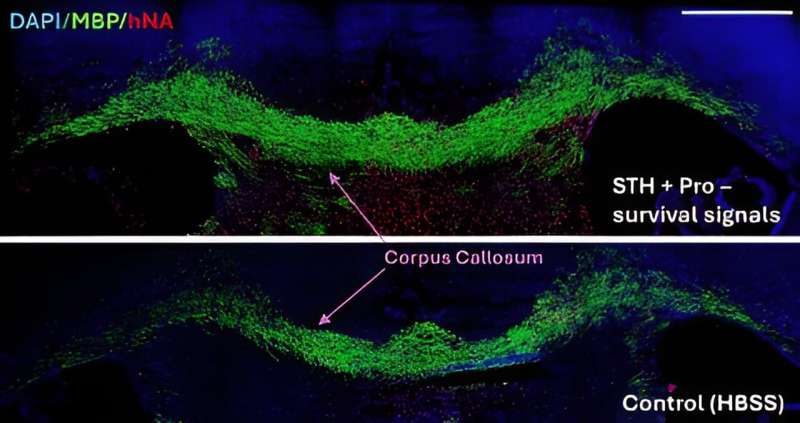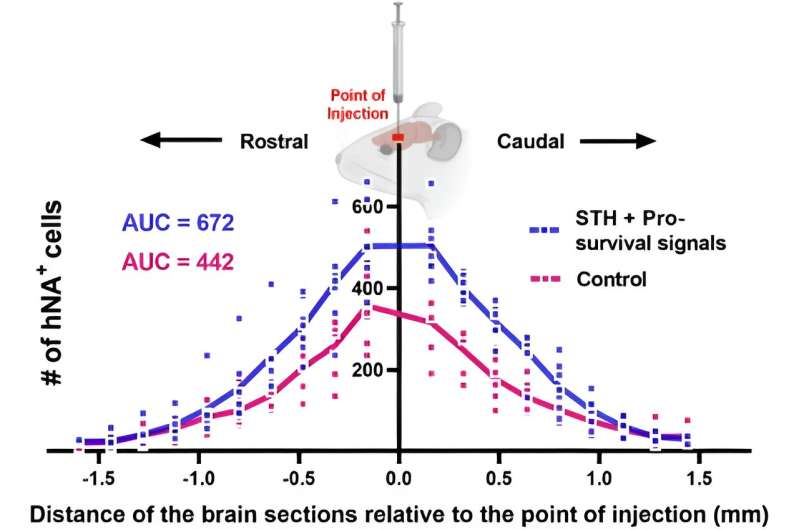This article has been reviewed according to Science X's editorial process and policies. Editors have highlighted the following attributes while ensuring the content's credibility:
fact-checked
peer-reviewed publication
trusted source
proofread
Most stem cells die after being injected into the brain. This new technique could change that

When the myelin sheath that surrounds nerve fibers in the brain and spinal cord becomes damaged, a number of debilitating conditions can result that limit mobility, inhibit independence and reduce life expectancy. Multiple sclerosis (MS) is the most common demyelinating disease, affecting more than 2.5 million individuals globally every year.
Stem cell therapy to treat such diseases often has disappointing results because the transplanted cells die off before they can take effect. In fact, more than 95% of neural progenitor cells (NPCs) transplanted into individuals with a spinal cord injury die following injection. This is partly because the process of injecting the cells can damage them.
Two University at Buffalo researchers are working on a possible solution: injecting shear-thinning hydrogels (STH) into the brain, which protect the cells and result in more successful therapy.
Stelios Andreadis, Ph.D., SUNY Distinguished Professor in the Department of Chemical and Biological Engineering in the School of Engineering and Applied Sciences, and Fraser Sim, Ph.D., professor in the Department of Pharmacology and Toxicology in the Jacobs School of Medicine and Biomedical Sciences and director of UB's Neuroscience Program, plan to further investigate this technology.
"STHs have emerged as promising candidates for the injection of Schwann cells and oligodendrocytes, the cells that form the myelin sheath in the brain and spinal cord," said Andreadis, who also directs UB's Cell, Gene and Tissue Engineering (CGTE) Center, of which Sim is a member.
"The work we plan to undertake has significant implications for regenerative medicine, as it has the potential to develop novel strategies to enhance stem cell delivery for treatment of devastating neurological diseases that remain intractable to current treatments."
Their paper is scheduled for publication in an upcoming volume of Science Advances.
How shear-thinning hydrogels work
The hydrogels are called shear-thinning because once you put in them in a syringe and apply pressure, they turn into a liquid form, Andreadis explained.
"They change their viscosity in response to shear stress, and they can turn back into gel form when the force is removed, after the injection," he said. "The fast transition from solid-like to fluid-like behavior, with increasing shear rate, is essential for successful injection and cell protection."
The STHs are also designed to mimic the mechanical properties of the brain tissue such as stiffness. And the treatments are minimally invasive.
"We don't open up the brain surgically," Andreadis said, "but rather are using syringes to perform in what is called stereotactic surgery."
Up until now, scientists have essentially put the stem cells into a simple saline solution before implanting them, Sim said.
"They just accepted the fact that a lot of cells will die when you transplant them," said Sim, whose lab investigates the molecular control of cell fate and homeostasis of resident stem and progenitor cells in the human brain.
"With the hydrogel, we can introduce different factors that will allow the cells to overcome the inhibitory environment that's present in MS lesions," Sim said. "We think this will improve the outcome of cell therapy over the vanilla approach using cells in a saline solution."

Testing on animal models that do not produce myelin
The two researchers began exploring STH technology a couple of years ago by transplanting human cells into the brains of a type of mouse that does not naturally produce myelin.
"The mouse's condition models congenital hypomyelinating diseases in humans such as Pelizaeus-Merzbacher disease, a rare and progressive degenerative central nervous system disorder," Andreadis said. "We found that implanting the hydrogels significantly improved the survival of the transplanted cells and enhanced nerve repair in the brain 12 weeks post-implantation."
The next step is to conduct testing on larger animal models with a brain size closer to that of humans. They are seeking answers to questions such as: How many cells do you need? Are the cells going in the parts of the brain where we want them to go? Are they migrating places that they're not supposed to migrate?
"These are some of the issues we'll be investigating in the next few years with support from the recent NIH research grant," Andreadis said.
"This is a great opportunity to marry biomaterials science and engineering with neuroscience to develop a therapeutic strategy that can, hopefully, be brought to the clinic to treat devastating diseases and conditions such as MS," Andreadis explained.
"While there is currently no cure, we would like to develop a successful therapy that can limit the disease's development and improve quality of life for MS patients and others who are suffering from neurological disorders."
Sim said he has been grateful for the opportunity to combine his expertise with that of Andreadis.
"This project is a wonderful example of collaborative science," he said. "Neither of us could do this work alone."


















